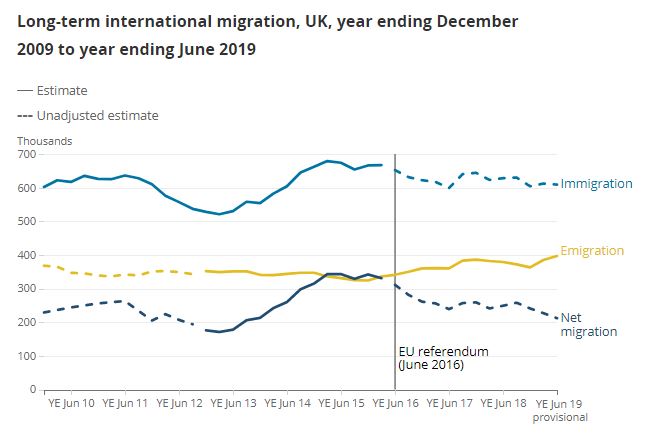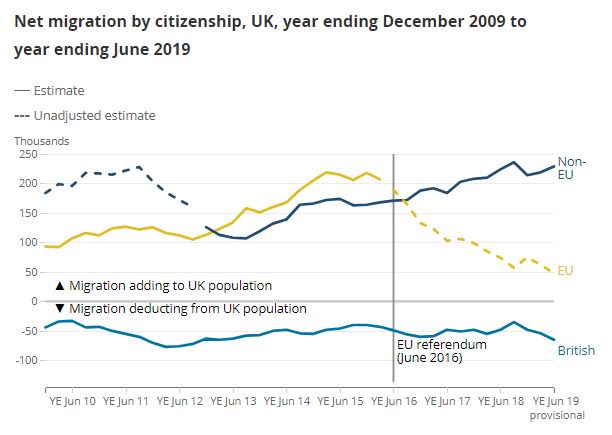Once the UK leaves the European Union (EU), a new immigration system will be introduced to replace the EU’s freedom of movement rule.
Taking control of immigration was one of the key themes of the Leave campaign in the 2016 referendum. Back then Michael Gove, Boris Johnson, Priti Patel, and Gisela Stuart said that if the UK voted to leave the European Union, EU citizens wanting to move to the UK would be subject to a points-based immigration system.
In a race to win the general election 2017, the UKIP leader, Paul Nuttall, promised that his party would reduce net migration into the UK to zero, meaning that the number of people arriving into the country would be about the same as the number leaving. In his view, the ambitious goal could be achieved by introducing an “Australian-style points-based system”.
Australia’s points system was introduced in 1989.
Applicants score points for youth, qualifications, and English-speaking ability if applying for a skilled job. Being aged between 25 and 33 years old will get you 30 points – almost halfway to the eligibility threshold of 65 points.
Unless applicants are being sponsored by an employer, they must also be applying to work in one of the trades or professions set out in a list by the Australian government. The numbers for each of these trades and professions are capped.
The Australian system is centrally planned, while the UK system trusts the employer to decide whether the person is qualified to do the job.
Migration Watch – a think tank calling for reduced levels of migration to the UK – has dismissed the idea of introducing a points system in the UK, saying it’s designed for a country like Australia that wants to boost immigration, and criticising it for its inflexibility. UK’s Home Secretary Priti Patel, however, has pledged to take back control over the country’s borders and “end the free movement of people once and for all”.
According to the figures by the Office for International Statistics (ONS) in the year ending June 2019, long-term international migration continued to add to the UK population as an estimated 212,000 more people came to the UK with an intention to stay 12 months or more than left the UK (net migration). Over the last year, 609,000 people moved to the UK (immigration) and 397,000 people left the UK (emigration). Since the end of 2016, long-term net migration, immigration and emigration have remained broadly stable.

Source: ONS
While overall migration levels have remained broadly stable since the end of 2016, patterns for EU and non-EU citizens have followed different trends. EU net migration has fallen following peak levels in 2015 and 2016, while non-EU net migration has gradually increased since 2013. For both EU and non-EU citizens, more come to the UK than leave the UK and they therefore continue to add to the UK population.

Source: ONS
In a move to curb low-skilled immigration and attract talent from all over the world, the government has proposed a “points-based system” for all migrants. Similar points-based immigration systems exist not only in Australia, but also in Canada and New Zealand.
Currently, those from within the EU do not need a visa to work in the UK because they benefit from “freedom of movement” – although there are limits on claiming certain benefits. For those from outside the EU, there is a system in place based on points awarded for having English language skills, being sponsored by a company and meeting a salary threshold.
There are four “tiers” of points-based visas for the following groups of non-EU migrants seeking skilled employment in the UK:
- Temporary workers, for example people coming to do seasonal work on farms or in a theatre production or on a charity project
- Students
- Skilled workers
- “High-value” migrants for example people with “exceptional talent” or major investors
The cap for work visas awarded based on points to non-EU migrants is set at around 21,000 a year. The points-based system for immigrants outside the EU was introduced by the Labour Party, under Gordon Brown, back in 2008.
The newly announced points-based immigration system will make migration to the UK much harder. As Home Secretary Priti Patel said in a speech at the Conservative Party’s annual conference in September 2019, the new ‘Australian style’ points-based immigration system would be the “one that works in the best interests of Britain [and] that attracts and welcomes the brightest and the best”.
So far, it is known that a post-Brexit immigration system will require skilled EU workers with a minimum salary of £30,000 to be sponsored by an employer. They will be able to bring dependants with them and there would be no cap on their numbers. A scheme for lower-skilled workers to come to the UK, on visas limited to 12 months, has also been planned. The government has yet to announce the final shape of the future immigration system, and pass it into law.
The new immigration system is likely to take different factors like skills and language into account when awarding visas, but focus on qualified immigrant workforce will remain. Last year Britain expanded its job shortage list to attract more qualified immigrants.
In their report on points-based system and salary thresholds, the government’s expert advisors, the Migration Advisory Committee (MAC), have recommended that the minimum salary for the admittance of a skilled worker from anywhere in the world, including EU nations, should be £25,600 – down from the current £30,000 for non-EU migrants.
As we wrote earlier, Boris Johnson has already announced a “global talent” visa which will replace the current “exceptional talent” route, but removing the cap on numbers. Currently there are 2,000 of these visas available a year and the cap is rarely reached.
Image: William Daigneault
If you have found a spelling error, please, notify us by selecting that text and pressing Ctrl+Enter.











Thanks!
Our editors are notified.